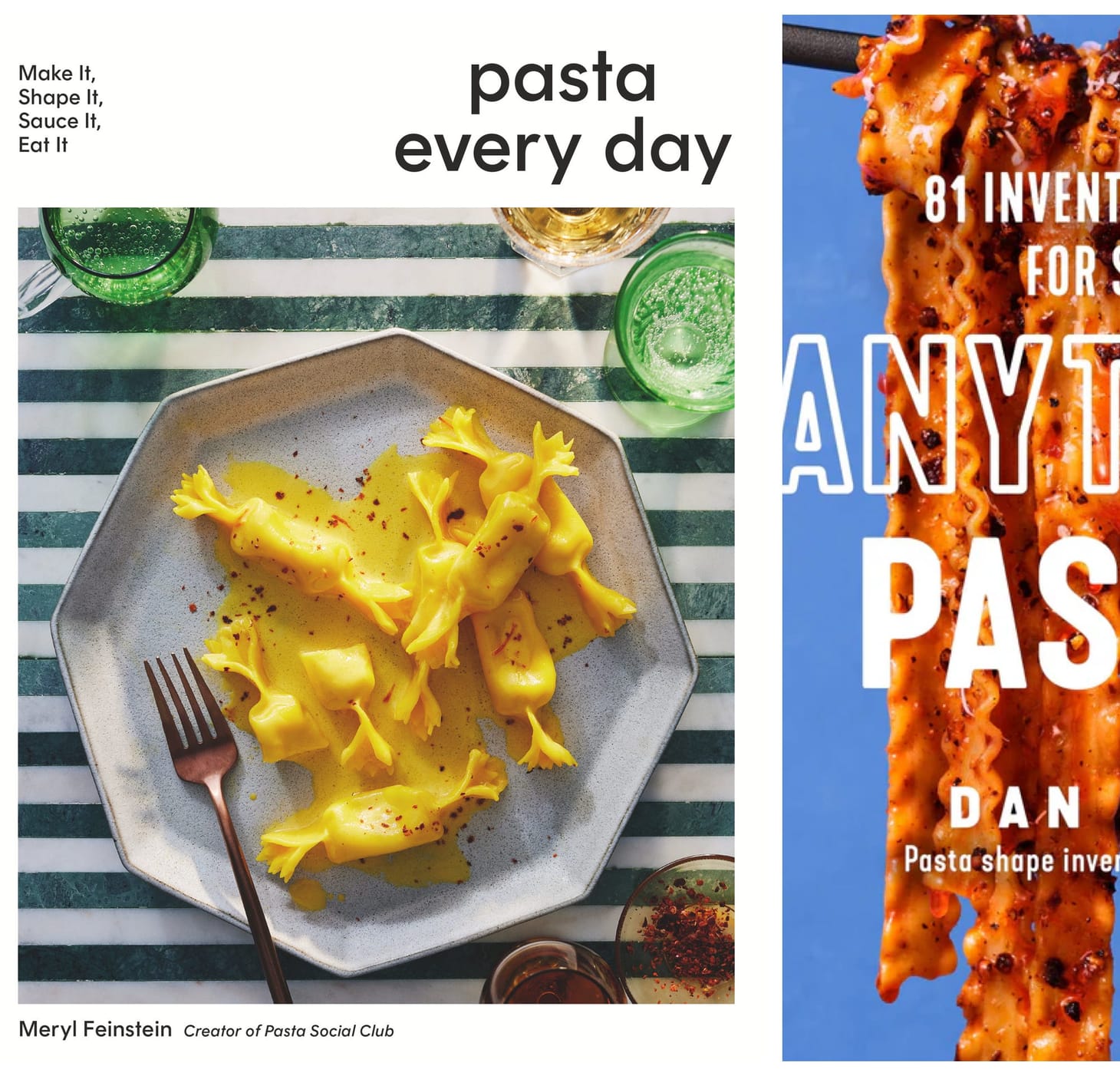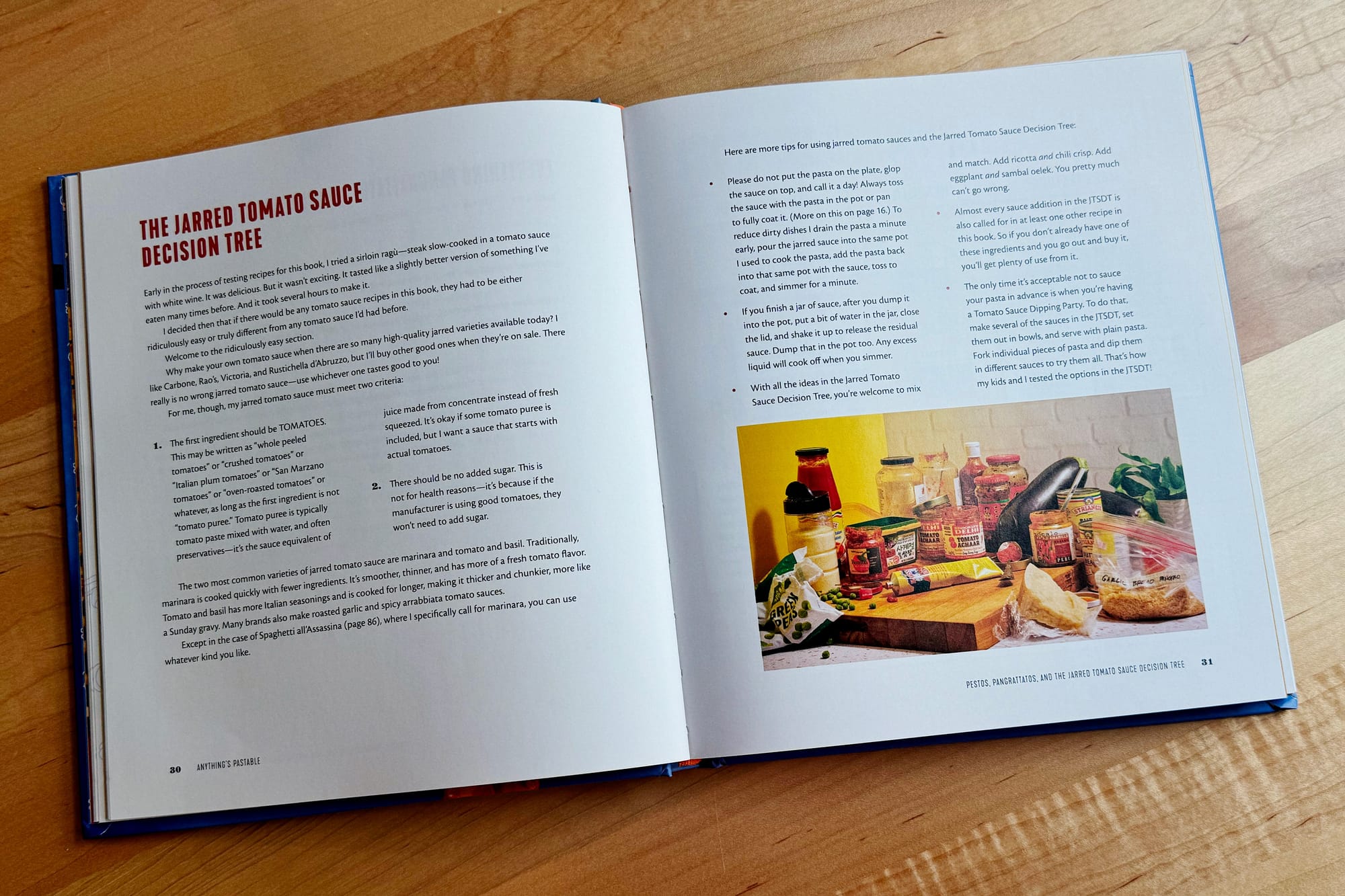Two Wonderful New Pasta Books
from Meryl Feinstein ('Pasta Every Day') and Dan Pashman ('Anything's Pastable')

Table of Contents
Today I want to feature two new pasta1 books, both from friends, and one of which I had (very minor) involvement in: Meryl Feinstein’s Pasta Every Day and Dan Pashman’s Anything’s Pastable.
What I love about these books—beyond their excellent recipes and technical information about pasta making—is that they are on opposite ends of the spectrum in terms of focus and content, and yet 100% complementary, making them worthy of inclusion on your cookbook shelf, side-by-side. They are also, incidentally, two books about pasta by non-Italians—Meryl and Dan are both Jewish-Americans, who bring an outsider’s perspective and curiosity to the subject matter—which I think only serves to strengthen the books and make them more approachable to readers.
Pasta Every Day, by , who has her own excellent newsletter, , was released last fall, and was just nominated for a 2024 James Beard award (alongside another Wordloaf fave, Homa Dashtaki’s Yogurt & Whey).
Of the two, Pasta Every Day is the technical pasta book, filled with recipes for making fresh pasta doughs and shapes of all kinds from scratch, with gorgeous step-wise imagery and detailed instruction and information on how to make each of them successfully. Of all the manuals of pasta making available, Pasta Every Day is my favorite, and, I think, an essential tome for anyone serious about learning the craft at home.

Pasta Every Day is a manual for making fresh pasta at home, but its thoroughness serves to make the subject more approachable, not less. Making fresh pasta isn’t hard, it just employs a set of techniques most of us are unfamiliar with. As Meryl says in introduction to the book:
[F]resh pasta is often misunderstood. It’s a simple food with humble origins, long a staple of home cooks like Barbara. But over time it’s become trapped by an intimidating reputation.
The first time my husband and I attempted fresh pasta was not in Modena but in Manhattan, a couple of years earlier when we lived in a 400-square-foot studio on the Upper West Side. It was an elaborate recipe for artichoke ravioli from The French Laundry (I know, I know). We started the dough at 4:00 p.m., took our first bite at 10:00 p.m., finished our plates at 10:05 p.m., and then ordered a pizza. This experience is not unique, but it should be. The idea that fresh pasta is a Michelin- level challenge, a minefield of fancy tools and complex techniques only fit for a restaurant chef, is a modern and American myth.
The truth is this: Anyone can make fresh pasta at home. What’s more, anyone can make great fresh pasta with what’s already in their kitchen.
I think bread is similar to pasta in this way: there is a lot to learn about all the different ways people make bread, but once you know it, the actual practice is mostly quite simple, and something that anyone can do.
Even if you had zero desire to make pasta from scratch, Pasta Every Day would be worth owning, because it also contains dozens of recipes for pasta sauces, fillings, broths, and toppings that would be equally delicious paired with fresh or dried pasta from the supermarket. All of the classics are here—meat ragùs, tomato sauces, cheese sauces, and a total of seven pestos—along with unusual and lesser-known ones, including two that Meryl has generously shared with Wordloaf—a vegetarian onion ragù and a broccoli sauce, both of which I can’t wait to make myself:
Anything’s Pastable is from Dan Pashman, the host and creator of the The Sporkful podcast and the inventor of the cascatelli pasta shape. Unlike Pasta Every Day, Anything’s Pastable is decidedly non-technical; there are no recipes for homemade pasta here. In fact, there are no recipes for fresh pasta at all; it is entirely about creating easy and mostly-quick meals using boxed, dried pasta.
There aren’t even any recipes for simple cooked tomato-based pasta sauces—instead, there is a “jarred tomato sauce decision tree,” meant to help you select the best possible jarred sauce from the supermarket, followed by a flowchart for how to easily zhuzh it up with other staple ingredients like chili crisp, fish sauce, and msg (all of which reappear in other recipes in the book).

Of course, Anything’s Pastable isn’t only a book about how to make dinner using boxed and jarred ingredients. The bulk of the book is 81 recipes for from-scratch composed pasta dishes, from reinterpreted classics, pasta dishes from other cultures—Italians may have elevated pasta-making to an art form, but they are hardly the only culture to consider noodles a beloved staple—and whimsical mash-ups of pasta classics with ingredients and flavors borrowed from other cuisines, like Mac n’ Dal, Kimchi alla Gricia, and Mapo Tofu Bolognese (a recipe contributed by my pal ).
Rather than develop all the recipes for the book himself, Dan assembled a team of experienced recipe developers from a wide variety of backgrounds—including a couple of friends and former ATK colleagues—and that’s one reason the book is so special. Each of them brings their own set of influences and expertise to the book, and it shows in the recipes they collectively produced.
When Dan first began working on Anything’s Pastable, he reached out to me if I wanted to be on the team, and while I absolutely wished I could have said yes, I had to pass, since I had a book of my own to work on. I did mention that I had a single dish I’d love to contribute, and I’m happy to say he included it in the book. It’s a pasta-fied version of Armenian manti, the lamb-filled dumplings in meat broth made most often around Christmastime. The real-deal manti is time-consuming and labor-intensive; this version, which I dubbed “The Faux Manti,” is a quick version of the dish, with shell pasta replacing the dumplings. It’s not my invention; I found versions of it in Armenian church cookbooks, though those were a little too simple for my taste, so I created one that retained as much as possible the character of the dish, without all the work. Dan offered to let me share it with Wordloaf readers, so you can try it out too:
As with many of my “new books I love” posts on Wordloaf, I have a drawing for paid subscribers. While I don’t have a copy of Anything’s Pasta to give away, I do have a signed copy of Pasta Every Day to send to one lucky subscriber. Additionally, I have an extra copy of Rachel Roddy’s An A-to-Z of Pasta to share, a book I featured previously here, and another I think essential for anyone serious about pasta making.
If you want in on the drawing for either book, leave a comment below with the best pasta or noodle dish you made or ate recently (also mention if you have either book already). I’ll pick two commenters at random a week from tomorrow, 5/17/24.
Pasta books, on a newsletter devoted to bread?! Bread bakers eat pasta too, you know, and in any case, bread appears often in both books, usually in the form of bread crumbs. ↩
wordloaf Newsletter
Join the newsletter to receive the latest updates in your inbox.




